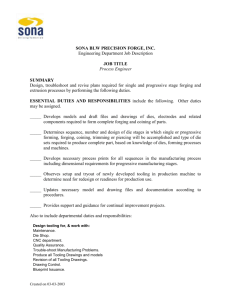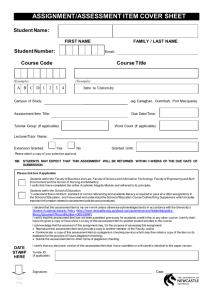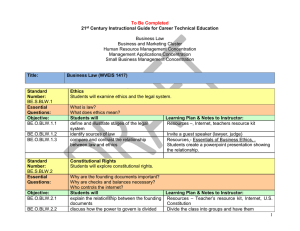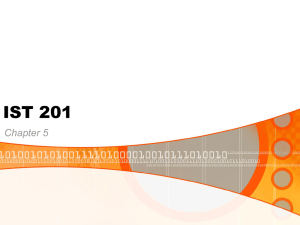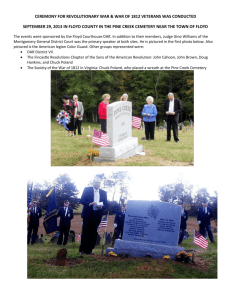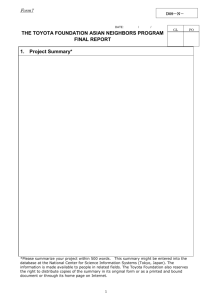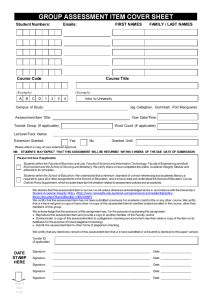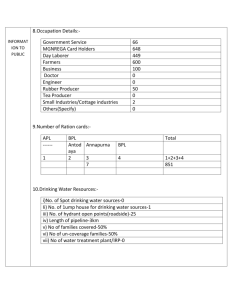1417 Business Law Instructional Guide
advertisement
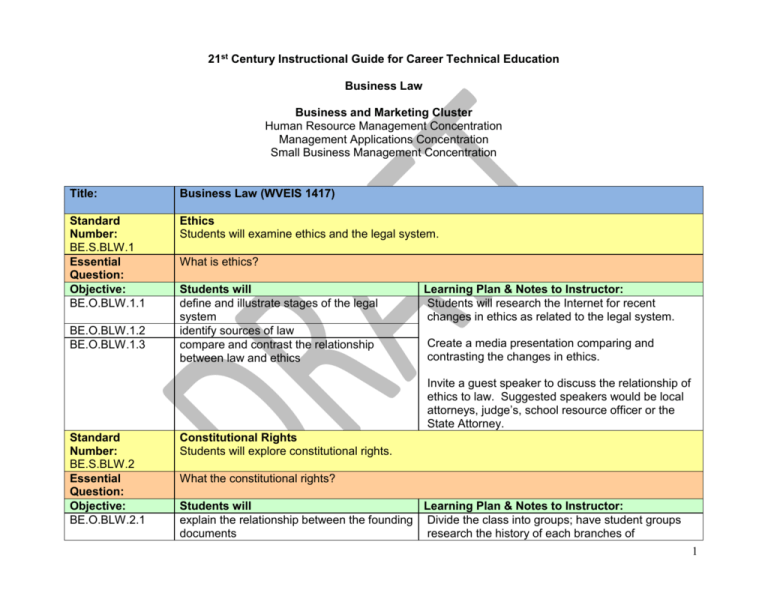
21st Century Instructional Guide for Career Technical Education Business Law Business and Marketing Cluster Human Resource Management Concentration Management Applications Concentration Small Business Management Concentration Title: Business Law (WVEIS 1417) Standard Number: BE.S.BLW.1 Essential Question: Objective: BE.O.BLW.1.1 Ethics Students will examine ethics and the legal system. BE.O.BLW.1.2 BE.O.BLW.1.3 What is ethics? Students will define and illustrate stages of the legal system identify sources of law compare and contrast the relationship between law and ethics Learning Plan & Notes to Instructor: Students will research the Internet for recent changes in ethics as related to the legal system. Create a media presentation comparing and contrasting the changes in ethics. Invite a guest speaker to discuss the relationship of ethics to law. Suggested speakers would be local attorneys, judge’s, school resource officer or the State Attorney. Standard Number: BE.S.BLW.2 Essential Question: Objective: BE.O.BLW.2.1 Constitutional Rights Students will explore constitutional rights. What the constitutional rights? Students will Learning Plan & Notes to Instructor: explain the relationship between the founding Divide the class into groups; have student groups documents research the history of each branches of 1 BE.O.BLW.2.2 BE.O.BLW.2.3 Standard Number: BE.S.BLW.3 Essential Question: Objective: BE.O.BLW.3.1 BE.O.BLW.3.2 BE.O.BLW.3.3 discuss how the power to govern is divided research internet related constitutional issues government and report the findings to the class. Develop a virtual field trip to Washington, DC to learn about The Constitution. Court Systems, Criminal, Civic and Business Law Students will examine the court systems, criminal, civil, and business law. What is the primary difference between the court systems? Students will describe the different levels of courts and their power compare and contrast criminal and civil law identify the types of crimes that affect business Learning Plan & Notes to Instructor: Use interactive media to create a chart that shows West Virginia state court system. Students will compare the court systems and research differences for accuracy. Invite judge’s from various levels of the court as speakers. Students will create a graphic organizer comparing and contrasting criminal and civil law about business crimes. Invite a guest speaker from your local community’s business leaders to speak concerning business crimes and how they deal with them. Review the National White Collar Crime website at www.nw3c.org. Blog your findings through a teacher generated discussion board. BE.O.BLW.3.4 distinguish a crime from a tort Contact the West Virginia State Auditor’s Security Commission Office for information regarding crimes that affect businesses. Request a speaker from the Securities Commission Office for the classroom. Use interactive media to list and define the common elements of a tort. Use responders to answer questions about the torts. 2 BE.O.BLW.3.5 recognize the procedures used to try a civil case Students, in groups, will role play a civil case generated by the instructor. Research a recent civil case in your area or at the State level. Discuss the pros and cons of the case and if students agree with the ruling. Find and view video clips of civil cases for classroom discussions. Standard Number: BE.S.BLW.4 Essential Questions: Objective: BE.O.BLW.4.1 Contracts Students will explore contracts. BE.O.BLW.4.2 discuss the requirements of an offer and acceptance identify parties who lack contractual capacity BE.O.BLW.4.3 What are contracts? Students will identify the elements of a contract BE.O.BLW.4.4 explain why the statute of frauds is necessary BE.O.BLW.4.5 identify the requirements and recognize the forms of consideration Learning Plan & Notes to Instructor: Use interactive media to discuss the six basic elements of a contract. Students will discuss why each element is necessary to legally enforce a document. Research and print contracts to compare. Students will summarize the requirements of a valid offer. On index cards write scenarios that depict enforceable and unenforceable contracts involving minors or others lacking contractual capacity. Divide the class in groups and have each group choose a card. Have students perform a skit based on the situation on their card. Students will research the Statue of Frauds and correlate the finding with executory contracts. Information on the findings will be submitted on a teacher generated blog. A group of students will draw up a written contract and create a scenario with a conflict that involves an 3 BE.O.BLW.4.6 identify the transfer of contract rights and duties BE.O.BLW.4.7 describe remedies possible for breach of contract recognize the contractual elements of premarital and marital relationships describe the various ways in which a marriage contract is ended BE.O.BLW.4.8 BE.O.BLW.4.9 exception to the parole evidence rule. The second group of students will act as judges to determine which exception will allow the oral statements into evidence. Using a digital recording device, record the role play to use in other classes. Use interactive media to list non-assignable rights and have students debate the difference between assignment and delegation. Use interactive media to list possible remedies for breach of contract. Students will use responders to rank the remedies. Students will write a marriage contract that lists spousal obligations and duties and responsibilities of parenthood. Invite a marriage counselor to speak to the class about typical problems a marriage faces. Contact an attorney specializing in family law to discuss divorce, marriage settlements, child custody, and divorce intervention. Standard Number: BE.S.BLW.5 Essential Question: Objective: BE.O.BLW.5.1 BE.O.BLW.5.2 BE.O.BLW.5.3 Consumer Law Students will explore consumer law. What is consumer law? Students will identify special rules for sales contracts research what is required for transfer of ownership of goods. discuss consumer protection legislation Learning Plan & Notes to Instructor: Request each student to bring in a bill of sale. Identify what features of the transaction are identified on the bill. Create a class chart of the exceptions to the general rule that only the true owner has the authority to transfer title to goods. 4 Students will research and keep a journal entry about how their lives are affected by the Consumer Product Safety Commission, the Food and Drug Administration, and the National Institute of Standards and Technology. Standard Number: BE.S.BLW.6 Essential Question: Objective: BE.O.BLW.6.1 Personal and Real Property Law Students will demonstrate legal rules that apply to real and personal property. What is the difference between real and personal property? Students will distinguish between real and personal property BE.O.BLW.6.2 investigate the ways in which bailments are created and ended BE.O.BLW.6.3 evaluate the rights and limitations associated with the forms of ownership of real property and how they are transferred Learning Plan & Notes to Instructor: Students will work in groups to create a collage that displays different forms of real and personal property. Students may use any media for the collage. Using a teacher generated list, students use responders to distinguish between real and personal property. Use the Internet to research bailments. Students will brainstorm and list the times they have been in a bailment with other students, family or friends. In groups of two, students will contact a local real estate agency to determine the cost involved in closing a residential real estate transaction and obtaining a loan. Invite a real estate agent or broker as a guest speaker. BE.O.BLW.6.4 show the kinds of rental relationships that Use a local newspaper, or real estate guide, select a piece of real estate for purchase. Research the cost involved in the purchase. Prepare a presentation on the real estate selected. The student assumes the role of the real estate agent in the presentation. Create a spreadsheet with two columns; label one 5 landlords and tenants may create. BE.O.BLW.6.5 recognize the common types of insurance and when an insurable interest is present Tenant and the other Landlord. Under both titles, record the rights and duties of each. Obtain rental contracts from a local real estate agent or property owner to compare and contrast. Create a spreadsheet with two columns; labeled Property and Life. Students will list the types of property and people in which a person may have insurable interest. Invite an insurance agent to speak on the different types of insurance. BE.O.BLW.6.6 differentiate between dying testate and dying intestate Students will compare the different types of insurance and determine the type which is more profitable. Students will research the Internet for different types of last wills and testaments. Students will draft their will. Invite an attorney who specializes in wills and/or a probate judge to discuss the fees involved to probate a will. Research West Virginia laws for testate and intestate. Standard Number: BE.S.BLW.7 Essential Question: Objective: BE.O.BLW.7.1 Agency and Employment Law Students will analyze agency employment law. What is an agency? Students will distinguish the scope of agency authority Learning Plan & Notes to Instructor: Students will create a four column spreadsheet to explain the ways agency authority may be created. Students will list the procedures in each column. Use 6 the following columnar headings: 1. express authority 2. implied authority 3. apparent authority 4. ratification BE.O.BLW.7.2 BE.O.BLW.7.3 discover the duties of an agent and principal research how employment contracts are made and terminated Student will research state or federal statutes that specifically hold a principal liable for violations of public safety or health statutes. Students will use the teacher generated blog to report their research findings. Students will draft paragraphs for an employee handbook. In one paragraph, create a contract that is terminable at the will of either the employer or employee. In another paragraph, indicate that the employer cannot fire an employee without good reason. Students will present their draft paragraphs to the class for discussion and critiquing. BE.O.BLW.7.4 BE.O.BLW.7.5 Review employment contracts from business and industry within the community. establish the employer and employees duties Students will compose a list of duties they believe they would owe their employer and their employer would owe them. Compare the students’ lists with the law’s expectations. relate the development of labor law to how a Students will research the origin of the label yellowunion is formed dog contracts and prepare a multimedia presentation on labor unions in the 20th Century as compared to the 21st Century. Students will present their presentation to the class for discussion. Students will write a brief essay on the pros and cons of labor unions in today’s society. Students will 7 download the essay to the teacher. Standard Number: BE.S.BLW.8 Essential Question: Objective: BE.O.BLW.8.1 BE.O.BLW.8.2 BE.O.BLW.8.3 Legal Forms of Business Organization Students will analyze legal forms of business organization. What are legal forms? Students will recognize the three basic business forms and the powers of a partner determine the powers of a corporation demonstrate the roles of general partners and limited partners Learning Plan & Notes to Instructor: Students will list advantages and disadvantages of each form of business organization. Create a large graphic organizer using interactive media. Label the organizer with Kinds of Partnerships and Partners. Students will come enter in the information into the graphic organizer. Students can research the history of the corporate form of business. Contact a representative from a local corporation to discuss mergers, acquisitions, and dissolving processes. Students will contact West Virginia government for information on setting up a limited partnership. Students will work in groups to write an agreement for two general partners and one limited partner. Standard Number: BE.O.BLW.9 Essential Question: Objective: BE.O.BLW.9.1 BE.O.BLW.9.2 BE.O.BLW.9.3 Borrowing Money and Paying Bills Students will explore negotiable instruments. What are negotiable instruments? Students will recognize the need for commercial paper distinguish negotiable from non-negotiable instruments distinguish financial transactions that are electronic funds transfers Learning Plan & Notes to Instructor: Students will contact business institutions in their community and ask them about commercial paper used in their daily operations. Students will form conclusions based on the contacts. Students will give examples of EFTs. 8 BE.O.BLW.9.4 BE.O.BLW.9.5 assess the importance of secured credit transactions discuss debtor protection available under the law Research the trend towards ATMs/Debit Cards replacing the need for traveler’s checks and hand written checks. Use interactive media to review with the students the history of secured transactions and the unity in procedure achieved by the acceptance of provisions in West Virginia. Students can research the Consumer Credit Protection Act and the Truth in Lending Act. Each student should find five facts about each set and share their facts with the class using their choice of presentation media. Standard Number: BE.S.BLW.10 Essential Question: Objective: BE.O.BLW.10.1 BE.O.BLW.10.2 BE.O.BLW.10.3 21st Century Skills Information and Communication Skills: Participating in the Student Organization Students will participate in a student organization. What are the benefits of a career, technical student organization? Students will assess the purposes and goals of the local student organization. discover the benefits and responsibilities of participation in student organization as an adult. demonstrate leadership skills through participation in student organization activities such as meetings, programs, and projects. Learning Skills & Technology Tools 21C.O.912.1.LS1 Students will assess the purposes and goals of the local student organization. discover the benefits and responsibilities of participation in student organization as an adult. demonstrate leadership skills through participation in student organization activities such as meetings, programs, and projects. Teaching Strategies Evidence of Culminating Activity Success Student recognizes information Students will create a role Arguments needed for problem solving, play based on a court presented in the role can efficiently browse, search case on a current event. play along with the and navigate online to access Students will develop a decision of the role relevant information, evaluates rubric to evaluate the case play as rated by 9 information based on credibility, evidence presented by social, economic, political prosecution and defense. and/or ethical issues, and presents findings clearly and persuasively using a range of technology tools and media. Thinking and Reasoning Skills: 21C.O.912.1.LS3 Student creates information using advanced skills of analysis, synthesis and evaluation and shares this information through a variety of oral, written and multimedia communications that target academic, professional and technical audiences and purposes. 21C.O.58.1.TT9 Student uses telecommunications tools (e.g., email, web pages, blogs, discussion groups, list-servs, etc.) to learn academic content and to gather, share and publish information to various audiences. Student engages in a critical thinking process that supports synthesis and conducts evaluations by applying comprehensive criteria. 21C.O.58.2.LS1 21C.O.58.2.LS2 Student draws conclusions from a variety of data sources to analyze and interpret systems. rubrics. Teacher created blog to include students research with guidelines for posting responses to peers. Student will blog research information and respond to at least two additional postings by peers. Teacher created scenarios for role playing to involve a dispute between a landlord and a tenant. Students will research rights and responsibilities of landlords and tenants to debate a solution the scenario. Teacher will create two blogs; one for the landlords and one for the tenants. Students will blog within their group on 10 21C.O.58.2.LS3 Student engages in a problem solving process that divides complex problems into simple parts in order to devise solutions. 21C.O.912.2.TT2 Student collaborates with peers, experts and others to contribute to a content-related knowledge base by using technology to compile, synthesize, produce, and disseminate information, models, and other creative works. The student will exhibit leadership, ethical behavior, respect for others; accept responsibility for personal actions considering the impact on others; take the initiative to plan and execute tasks; and interact productively as a member of a group. Student models ethical behavior relating to security, privacy, computer etiquette, passwords and personal information and demonstrates an understanding of copyright by citing sources of copyrighted materials in papers, projects and multi-media presentations. Student advocates for legal and ethical behaviors among peers, family, and community 21C.S.9-12.3 Personal, and Workplace, Skills: 21C.O.912.3.TT5 research involved with the scenario. Teacher will create a wiki for the course to use to disseminate and receive student assignments. Students will use the course wiki to communicate with the teacher for daily activities and post their completed assignments and/or progress. 11 regarding the use of technology and information. Learning Skills & Technology Tools B Entrepreneurship Skills: D E H Culminating Assessment: Student understands the personal traits/behaviors associated with successful entrepreneurial performance. Student understands concepts, strategies, and systems needed to interact effectively with others. Student understands concepts and procedures needed for basic computer operations. Student understands concepts and strategies needed for career exploration, development, and growth. Teaching Strategies Culminating Activity Students will process leadership, personal management, communication, and interpersonal skills as they engage in collaborative work, decision-making processes, operate multimedia equipment, and draw career conclusions. Evidence of Success Students will display appropriate leadership, communication, and interpersonal traits/behaviors in personal applications and collaboration with others. Students will use basic computer operations to complete tasks and projects. Students will draw conclusions regarding educational requirements, job duties, and salary expectations in their area of interest. Culminating Assessment: Students will participate in a mock trial based on a case that they have researched. Each student will be assigned a specific task related to the trial. The trial will be conducted in an assembly for the high school students to observe and digitally recorded for classroom instruction. FBLA Competitive Events End-Of-Concentration Performance Assessment Links and Other Resources Related Websites: 12 Links and Other Resources www.ethics.org www.legalethics.com www.wv.gov www.courttv.com www.cpsc.gov www.fairhousing.com www.virtual-law.com/will2htm www.lawxtra.swlearning.com www.wvsao.gov www.thomas.loc.gov Pathways to Success http://careertech.k12.wv.us/pathwaystosuccess/ U.S. Department of Labor in the 21st Century http://www.dol.gov/ America's Career InfoNet www.acinet.org America's Job Bank www.ajb.org America's Service Locator www.servicelocator.org Employment & Training Administration 13 www.doleta.gov Monthly Labor Review Online: Labor Force Archives http://www.bls.gov/opub/mlr/indexL.htm#Labor force Occupational Information Network www.doleta.gov/programs/onet Office of Disability Employment Policy www.dol.gov/odep Workforce West Virginia https://www.workforcewv.org/ Books Basic Contract Law, Fuller and Eisenberg Civic Disobedience, Henry David Thoreau Origin of the Common Law, Arthur R. Hogue The Complete Book of Small Business Legal Forms, Daniel Sitarz Business Law and the Regulations of Business, Mann & Roberts Contacts: Contacts: Business Teachers: Utilize K12 Business Marketing Listserv at K12-BUSMKT@listserv.wvnet.edu Business Coordinator: Abby Reynolds, areynold@access.k12.wv.us OCTI Assistant Executive Director: Donna Burge-Tetrick OCTI Executive Director: Gene Coulson 14
